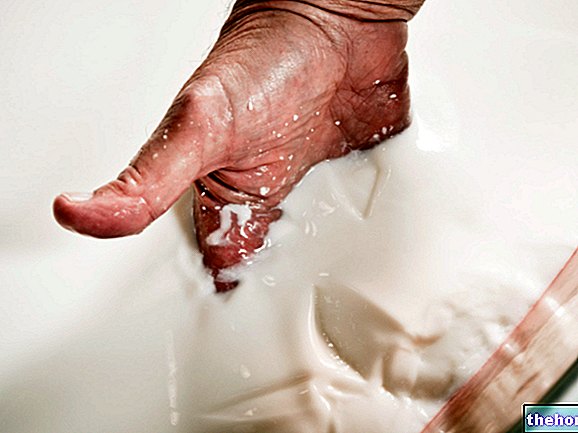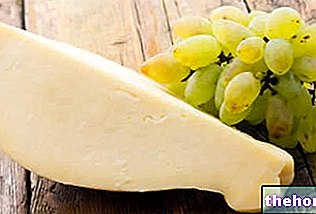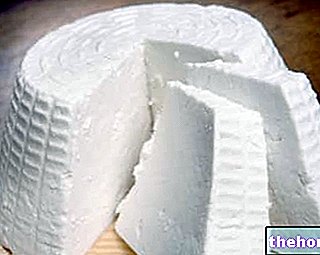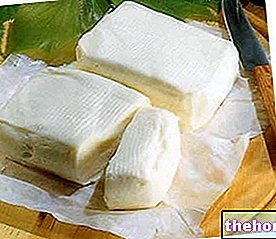What is Mascarpone
Mascarpone is a soft cheese typical of some Lombard territories, in particular of the Lodi and Abbiategrasso area.

In some countries, such as the United States, mascarpone is replaced by Cream Cheese, similar product but prepared with a different food technology.
Known in Italy as "Philadelphia", Cream Cheese is the classic Creamy Spreadable Cheese and, to tell the truth, its assimilation with mascarpone is rather inappropriate, not only for the differences from a product and technological point of view, but also for the different nutritional profile. To understand why, at the end of the reading, I suggest you also consult the article: Philadelphia - cheese.

Nutritional values (per 100 g of edible portion)
Unlike other cheeses, mascarpone is not obtained from milk, but from its cream (also known as cream). This is heated to 80-90 ° C and added to citric acid, tartaric acid or lemon juice while stirring the mixture (the coagulation of the cheese is due precisely to the combination of acidity and heat). At the end of this phase, the product is left to cool for 24 hours, at the end of which, as it does not require seasoning, it is ready for consumption.
Although, due to this particular processing method, it is excluded by many from the category of cheeses, according to Italian law mascarpone must be considered as such. It appears as a very delicate cream, with a color that varies from snow white to yellow. straw yellow; the flavor is delicate, tending to a sweet taste and vaguely reminiscent of the sour one of cream.
The storage time is limited, for this reason it should be kept in the refrigerator and consumed as soon as possible, especially if fresh. When packaged in sterile and / or vacuum-packed conditions, mascarpone extends its expiration date up to two weeks after packaging. Once opened, however, it should be consumed within a couple of days, as it tends to go rancid rather quickly.
Gastronomic Applications
Tasty, creamy and velvety, mascarpone can also be tasted naturally. It is sometimes used in place of butter, as a seasoning fat. It is not uncommon for it to be added to other ingredients (eg gorgonzola, walnuts, speck, salmon, shrimp, crab, chives, olives, capers, truffles, etc.) to make cold or hot creams; these can be eaten on croutons (as an appetizer), but also as a condiment for pasta, risotto or pizzas (as a first course or single course).Inside the main courses, this cheese acts as an emulsifying agent for sauces (for example that of a fillet with pepper or scallops) or to finish off the light base of a full-bodied roast.
Mascarpone is also part of many pastry specialties: it can serve as a filling (eg panettone, crepes, millefeuille etc.) or structure the preparation of the famous tiramisu (amalgamated with liqueurs, sugar, egg yolk, coffee and a sprinkle of cocoa). For the sweet tooth, it goes brilliantly with hazelnut spreads (such as Nutella), but does not disappoint when combined with large and sweet seasonal strawberries. It is also used as a base for some semifreddo or mixed with custard as an alternative to the classic diplomatic cream.
Nutritional Properties
Compared to butter and cream (or fresh cream), mascarpone is roughly a middle ground. Lipids and energy, although 40% lower than butter, are still excessive to characterize a food to be used as a dish. It is therefore a cheese to be considered as a seasoning fat, with the only advantage (poor consolation) that it provides more proteins.
It is therefore good not to overdo the consumption of mascarpone.
In the fresh one, produced with cow's milk, the percentage of lipids is around 47%, while in that obtained from buffalo milk it is even higher.
Although the precise data is missing from the table, the cholesterol rate is also very high (around 95mg per 100 grams of product). Furthermore, the breakdown of fatty acids is in favor of the saturated ones, therefore it is a completely unsuitable food for the hypercholesterolemic diet.
Proteins (albeit with a high biological value) are rather moderate and carbohydrates are almost marginal. Fibers are absent.
Among the mineral salts there are no noteworthy concentrations, while as regards the vitamins the levels of riboflavin (vitamin B2) and equivalent retinol (vitamin A) are appreciable.
Homemade Mascarpone - Video Recipe
Making mascarpone at home is a rather simple "operation, especially for our personal cooker, who in this video recipe explains in detail how to do it. Go with Doses and Ingredients!
Mascarpone - How to make Mascarpone
Problems with playing the video? Reload the video from youtube.
- Go to the Video Page
- Go to the Video Recipes Section
- Watch the video on youtube
Don't miss the video recipe of homemade vegan mascarpone!
See also the Cream Cheese recipe, in the traditional and vegan variant
And after learning how to make mascarpone, why not make a delicious strawberry tiramisu? How do you say? Too Many Fat and Calories? No fear! Saving calories and "useless" fats without sacrificing taste is Alice's mission, who has a special recipe in store, a light tiramisu without mascarpone or egg yolks
Milk, Dairy Products and Cheeses Asiago Brie Burrata Caciocavallo Rennet Camembert Cheddar Milk Cream Crescenza Emmental Feta Milk Flakes Fontina Herbal Cheeses Lean Cheeses Cheeses rich in calcium Gorgonzola Gouda Grana Padano Gruyere Kéfalair Adapted milk Artificial milk Condensed milk Asphyxiated milk Goat's milk Sheep's milk Rice milk Soy milk Powdered milk and concentrated milk Skimmed and semi-skimmed milk Lactose-free milk Milk Vegetable milk Dairy products Lerdammer Mascarpone Montasio Buffalo mozzarella Mozzarella Whipped cream Cooking cream Fresh cream Parmigiano Reggiano Pecorino Philadelphia Primo Sale Provolone Ricotta Robiola Roquefort Scamorza Sottilette Squacquerone Taleggio Tomino Yogurt OTHER ARTICLES MILK AND DERIVATIVES Categories Alcoholic foods Meat Cereals and derivatives Sweeteners Sweets Offal Fruit Dried fruit Milk and derivatives Legumes Oils and fats Fish and fishery products Cold cuts S pezie Vegetables Health recipes Appetizers Bread, Pizza and Brioche First courses Second courses Vegetables and Salads Sweets and Desserts Ice creams and sorbets Syrups, liqueurs and grappa Basic preparations ---- In the kitchen with leftovers Carnival recipes Christmas recipes Light diet recipes Women's Day, Mum, Dad Recipes Functional Recipes International Recipes Easter Recipes Recipes for Celiacs Recipes for Diabetics Recipes for Holidays Recipes for Valentine's Day Recipes for Vegetarians Protein Recipes Regional Recipes Vegan Recipes




























